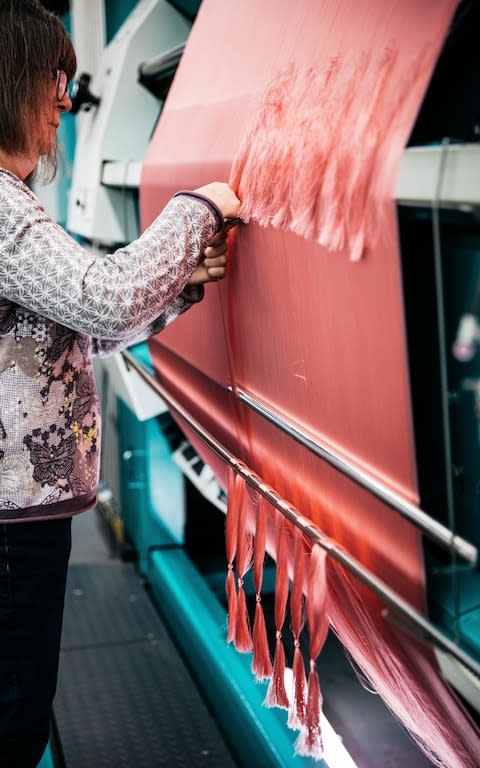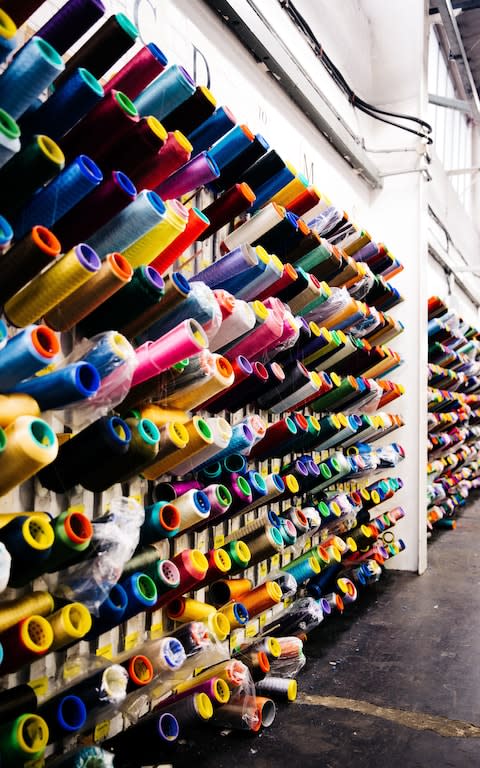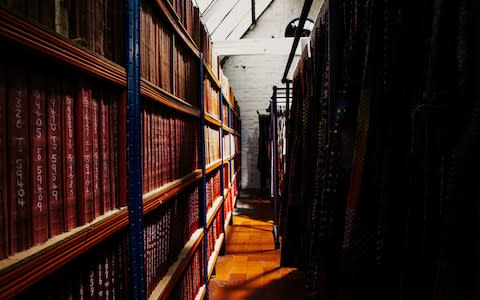Inside Vanners, makers of the silks for the most sumptuous dressing gowns imaginable

A stone’s throw from the stately Beau Brummell statue on Jermyn Street in St James’ - known as Mecca for traditional menswear - two store windows look upon the fellow’s swaggering form. Thankfully, the offering within is up to the original dandy’s high standards.
New & Lingwood, a treasure trove of gentlemanly accessories and nightwear, was founded in 1867 at Eton to create clothes for the students. There are, in fact, two New & Lingwood stores; one devoted to tailoring and accessories and the other, in Piccadilly Arcade, home to sumptuous silk dressing gowns.
Forget cosy cocoa, these are the gowns of Noel Coward-esque raffishness, of gentlemen at Albany, of Jeeves & Wooster bachelors with valets (or if you happened to catch the TV adaptation of John Le Carre’s The Night Manager, of Hugh Lawrie’s deliciously villainous Richard Roper).
If the standard towelling robe is the sartorial equivalent of a Pret sandwich, these silk creations are an eight-course tasting menu at Le Gavroche.

Which makes the nondescript, industrial building in the quiet Suffolk market town of Sudbury from which they originate, all the more surprising.
Vanners is the artisanal silk maker that provides the lavishly printed silks for New & Lingwood’s dressing gowns, and is one of the oldest companies in the silk weaving industry. Vanners was founded in 1740, springing from the Huguenot silk weavers who had recently fled persecution in France and set up shop in Spitalfields.
The artisans gradually dispersed and found themselves in a bucolic corner of Suffolk, just over the Essex border, not far from east London. From this wellspring, Stephen Walters & Sons and Gainsborough Silks formed a holy trinity, all them still based within a few miles of each other.

Despite the fact that we could be in any rain-washed industrial park in any town across the country, the sense of history is immediately clear within the walls of Vanners, which are lined with imagery charting the company’s journey, from satellite sites in London in the Victorian period to fragments of silk dating back centuries.
And the richness of the fabrics, not to mention the exceptional level of skill involved in creating the silks, is immediately apparent. A room of fabrics is like the most luxurious curiosity shop of a haberdashers you’ve ever seen.
Swatches in shades of amber, peacock blue, amethyst, citrine, claret and scarlet are decorated with swooping birds of paradise, tropical flora, dancing fauna, chinoiserie peacocks and dragons.
The latter will form the silk for a New & Lingwood dressing gown with a dragon wending its way up the torso against a turquoise backdrop, spouting flames. As I said, this is not the stuff of sedate Sunday slumbering.

The process to create such a piece, as expected, is an involved one. Vanners employs around 80 people, and processes around 180,000 to 200,000 metres of silk per year, supplying not just New & Lingwood but a host of brands, including Ralph Lauren and Brooks Brothers.
The starting point is a digital pattern design, which comes either from an in-house designer or from New & Lingwood; in many cases, customers will commission bespoke designs that incorporate their own designs (a family crest is a popular choice).
The calculations for the design will then be translated to the looms digitally - prior to this, every minutiae had to be hand-painted into a chart that would act as reference - with the warp as the fine base layer and the weft as the thicker, decorative layer on top.
Silks arrive at the factory in their raw state: the highest grade grown in China in ice white, to allow them to be dyed in-house.

The factory works with around 200 colours, however if you’re of a particularly demanding nature and the spectrum isn’t to your taste, they can develop more. Once dyed in steel vats for two hours, the silks are fed through what is effectively a giant microwave, incredibly slowly. And that’s the easy part.
The loading of the cones to make a particular design - that is, where the spools will be positioned on the loom to begin the process to start weaving a pattern - takes around eight hours, a full working day.
It’s a fantastical spider's web of fine threads, reeled across an expanse of space and into the loom itself, a network of crimson red or canary yellow, which once loaded takes a further eight hours to create.

The looms can deal with up to eight colours on one pattern. From there, quality checks are employed by the artisans, scouring the yarns for needle marks or discrepancies with the pattern, before it's treated to a liquid “bath” to soften it.
“One of the things we talk about a great deal at New & Lingwood is the Englishness of the brand,” says Simon Maloney, creative director. “We were founded at Eton, after all, and we like to source English suppliers wherever possible. The area in which Vanners is situated is the birthplace of the silk industry in the UK, and it’s a pleasure to be able to tell a story with them.”

The finished product; Tropical dressing gown, £2,500, New & Lingwood
It’s particularly pertinent when customers call into question the cost of the gowns, which run into the thousands. “The silk production is part of the reason someone invests in one of these gowns, and they really are heirloom pieces, like jewels or family treasures,” says Maloney.

Exotic dressing gown, £1,250, New & Lingwood
“They will be around much longer than we will. It’s a pleasure to work with the mill, you learn something new every time, and more and more we’re seeing that people are interested in bespoke craftsmanship and pieces with a specialness and longevity.” And there’s no British silk maker more special, or with more history, than Vanners.
Sign up for the Telegraph Luxury newsletter for your weekly dose of exquisite taste and expert opinion.

